If I had to choose a favorite wild edible, it would be the hazelnut. Rich in protein, fat, and flavor, hazelnuts make a satisfying snack, and can be used in cooking wherever you would use their commercially available counterparts (called filberts or hazelnuts). The two species native to North America are the American hazel (Corylus americana) and beaked hazel (Corylus cornuta). Both are common shrubs, and if you find a few specimens that produce well, foraging for hazelnuts is as easy as going to the grocery store. Read on, and you will learn how to identify and where to look for wild hazelnuts.
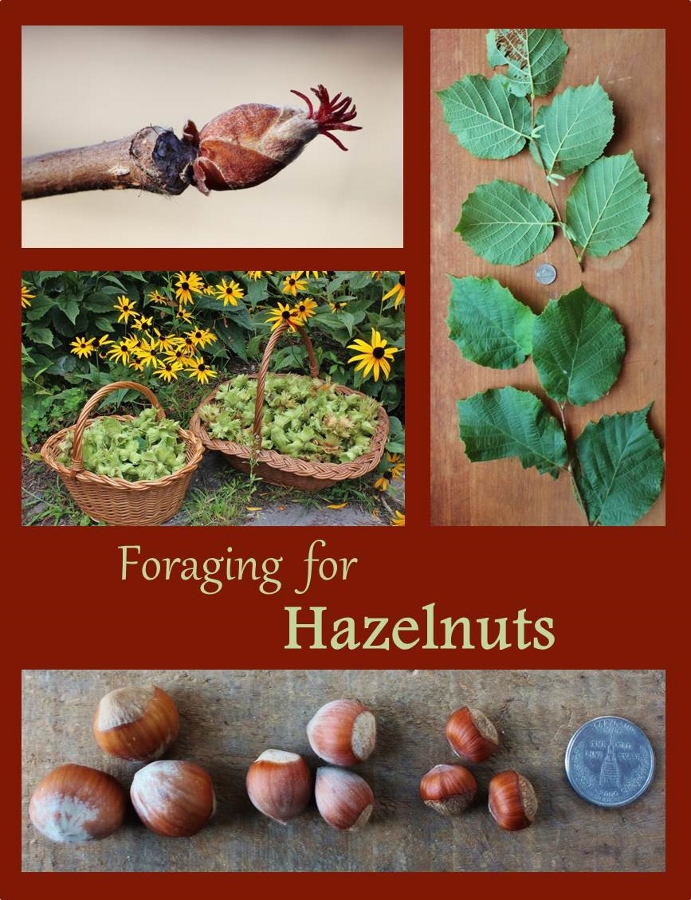
Foraging for Hazelnuts – How to identify, where to find, and how to harvest one of the best wild edibles.
General description of American hazel and beaked hazel
With good sun exposure, both American and beaked hazel grow as multi-stemmed shrubs that reach about 12 feet here in central New England. I have read that beaked hazel can grow to 25 feet, but perhaps that is in the more southerly portions of its range, because I’ve yet to see one reach anywhere near that height, here. In full sun, both species grow as large, dense, roundish shrubs, but in the shade they are often small and spindly. Such specimens are extremely common in the forest understory in my neck of the woods, but they do not produce many nuts.
It is said that beaked and American hazels occasionally grow as single stemmed trees, but I have never seen one grow like that in the wild. (In contrast, most Corylus species used for commercial production of hazelnuts usually do grow as trees.)
Hazelnut twigs and flowers
While the leaves make identification a lot easier, it’s fun to try to find these shrubs in winter and early spring, before they leaf out. Both species have brownish-gray twigs that don’t immediately stand out from other shrubs, but the catkins (male flowers) can be easily recognized in winter, well before leaf out.
You can even use the catkins to distinguish between American and beaked hazel, for those of the former species are borne on little stalks (as in my photo) while those of the beaked hazel are sessile (attached directly to the twig, with no connecting stalk). In winter, the brown catkins are small and tight, sometimes no more than an inch long. In early spring, the catkins release pollen as they grow to several inches in length.
The tiny, red, fringe-like female flowers bloom in early spring, by mid-April here in Massachusetts. They are so inconspicuous that few people ever notice them unless a botanist points them out. But tiny plant structures fascinate me, so I wait for these little jewels every spring, and that’s when anticipation of the year’s hazelnut harvest begins for me. The flowers of American hazel and beaked hazel are virtually identical, as far as I know. At least, I cannot distinguish between them with the naked eye.
Hazels need good sun exposure to bloom well, and because blooming is necessary for nut production, those in sunny spots will be more productive. Pollination is also necessary for nut production. Both Corylus americana and Corylus cornuta are pollinated by wind, and require cross pollination to produce fruit.
Hazelnut leaves
The toothed, oval leaves are alternately arranged on the twig. The leaves of Corylus americana are shown in the photo, and those of Corylus cornuta are almost identical. Note that in the photo, taken in August, you can see small, tight, green catkins. These will become the male flowers which will shed pollen next year. By August, the current year’s catkins have long since shed their pollen, and most of them have fallen off.
The nuts of American hazel and beaked hazel
Each nut is wrapped in a modified leaf called an involucre. These leafy green wrappings make the nuts very difficult to see, and it doesn’t help that they tend to be hidden under leaves. But it’s a little easier if you know what you’re looking for.
American hazel involucres have fringed edges which can be pried apart once the nut plumps out. The nuts can grow singly or in clusters of up to about 12. Beaked hazel involucres are covered with pinchy fuzz and taper into a long, beak-like end. Beaked hazelnuts typically grow singly or in clusters: up to 11 according to my reading, but I haven’t seen clusters of more than 3.
Both American and beaked hazelnuts are smaller than commercially produced European hazelnuts. That’s why the native American species are not usually grown commercially – people prefer the larger European nuts. But I think wild American hazelnuts taste better. They are slightly sweeter and milder in flavor.

Foraging for Hazelnuts. Photo shows European hazelnuts left, hybrid American x European hazelnuts center, and American hazelnuts right
Where to forage for hazelnuts
First, you need to know if they grow in your area. American hazel ranges over most of eastern North America. Beaked hazel ranges from the southern half of Canada to the northern half of the US, generally, but also extends down into Georgia and Alabama. These widely ranging shrubs are said to be tolerant of many soil types, as long as drainage is good. But in my experience, they are not even that picky about drainage, for the most productive individuals I’ve found of either species grow at wetland edges.
Once you know you are foraging within the range of one or both species, and you have learned the basics of identification, the key is to find bushes that produce a lot of nuts. You’ll find the best producers growing in sun exposed clumps.
Why good sun exposure? Because sunlight helps them bloom more profusely. Since fertilized female flowers develop into nuts, more flowers mean more nuts.
Why clumps? Remember that hazel flowers are pollinated by wind, which does not reliably deliver pollen from one individual to a far away neighbor. Those growing in clumps, on the other hand, can be easily pollinated by close neighbors.
So remember: look for highly productive bushes growing clumps in sunny areas. Both species often grow in oak/pine forests, but produce well only if the tree canopy is open, allowing plenty of sunshine to reach the hazels.
How to harvest wild hazelnuts
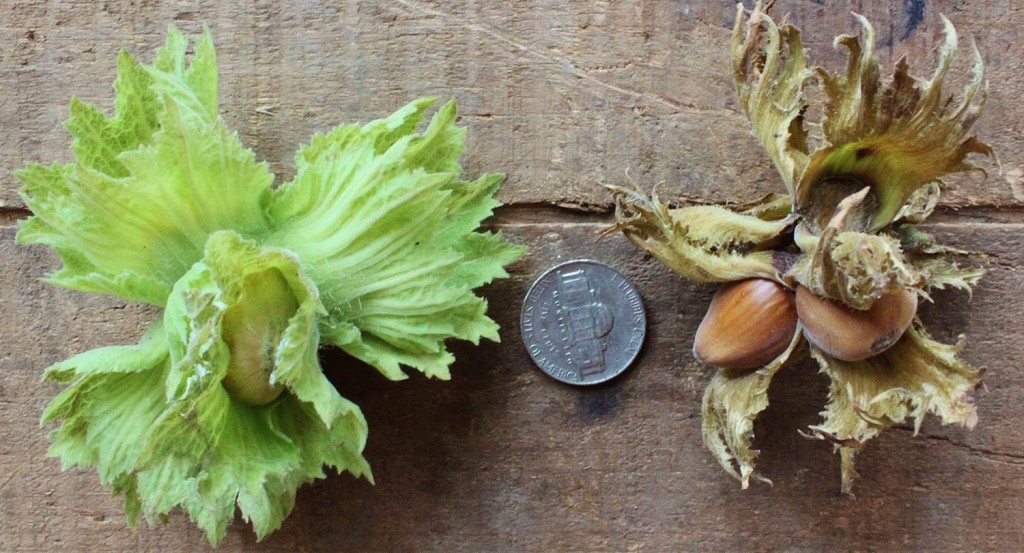
Clusters of hazelnuts in their involucres. Cluster at left is ready to pick, even though involucres are green. Cluster at right is riper, but some nuts have fallen out.
The nuts of Corylus americana begin to turn brown before the involucres do, as you can see in the photo. And that’s when you want to pick them: when the nuts are beginning to turn brown but the involucres are still green. By the time the involucres turn brown, many of the nuts will have fallen to the ground or will have been harvested by a wild animal. So if you hope to get some nuts, you must learn to recognize the clusters when they are still green. The cluster on the left in the photo is ripe enough for harvesting. The cluster on the right with the brown involucres has already lost some of its nuts. Don’t wait that long to harvest them.
If you find an American hazel bush packed with nuts, you can harvest quite a lot of them within a very short time. Pull entire clusters right off the bush. If you like, you can pick the nuts out of the involucres right away, but the nuts are much easier to remove if you first allow the clusters to dry. Spread them out in a dry place, and after several days, the nuts will be easy to pluck.
To make sure they are good and dry for long-term storage, I put the nuts, free of involucres but still within their shells, out in the sun for about a week. I usually put them on an old screen set on a wheelbarrow, to ensure good air circulation while the nuts dry.
In his book Nature’s Garden: A Guide to Identifying, Harvesting, and Preparing Edible Wild Plants, Sam Thayer says that in most years, most of the nuts of American hazel are either empty or wormy. This may vary regionally, as I have not found that to be the case here in east-central Massachusetts. I would estimate that about 80% of the American hazelnuts I harvest contain good kernels.
Beaked hazelnuts are more difficult to extract from their pinchy involucres. Don’t try to remove them before the involucres have been dried or rotted. Dry them as described for American hazels, or rot them as Sam Thayer does. He buries them in wet soil for a month, during which time the involucres soften, so that the fuzz is no longer pinchy. If you choose to dry rather than rot the involucres, you might want to wear gloves while removing them or you will get a lot of little spines stuck in your hands.
Both species of hazelnut are delicious, but ease of husk removal is a decision maker for me. In fact, I like American hazels so much that I’ve planted five bushes in my yard. So now I do most of my hazelnut harvesting right outside the back door. But, as an admirer of wild plants, I still delight in studying the leaves, twigs, and inconspicuous flowers of wild hazels, and partaking of their fruits, during my late summer wanderings.
Preparing and eating wild hazelnuts
Wild hazelnuts can be used in any recipe that calls for hazelnuts, for the flavor is very similar, if not better, than the commercially produced nuts. I sprinkle them in yogurt, oatmeal, and salads, and use them in baked goods. I make nut butter and chocolate hazelnut bark, and add them to ice cream. Check out my recipes for autumnberry hazelnut ice cream pie, and elderberry ice cream with chocolate hazelnut crunch.











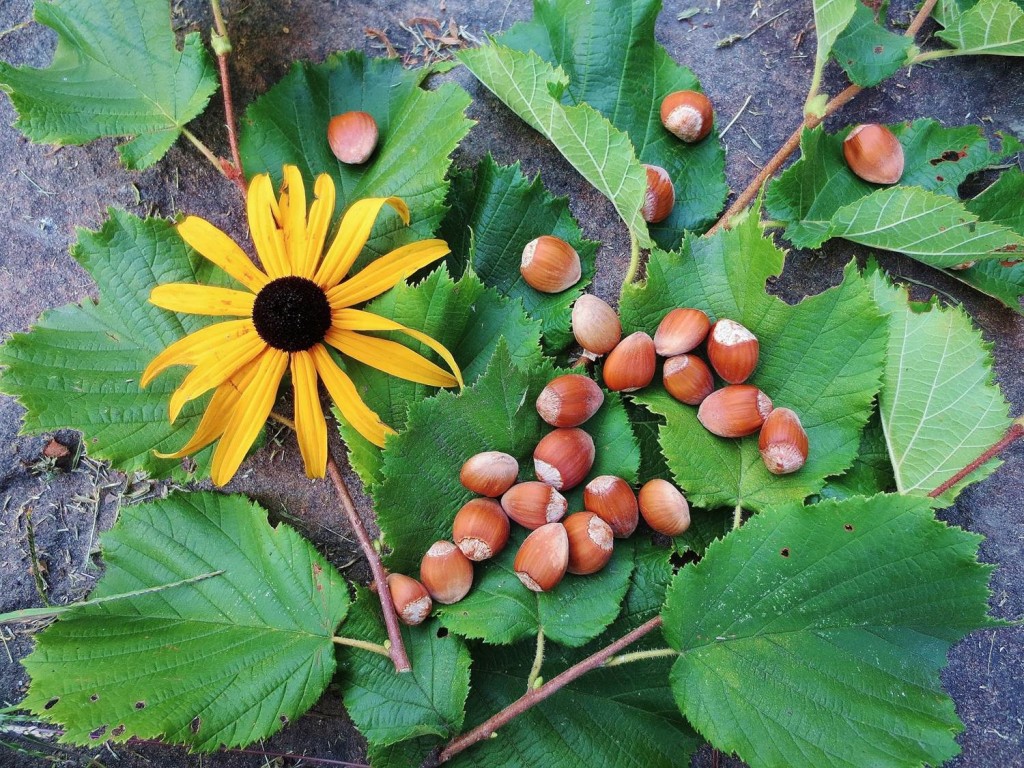
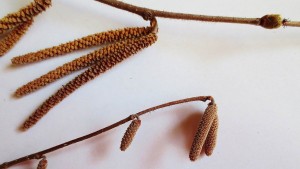

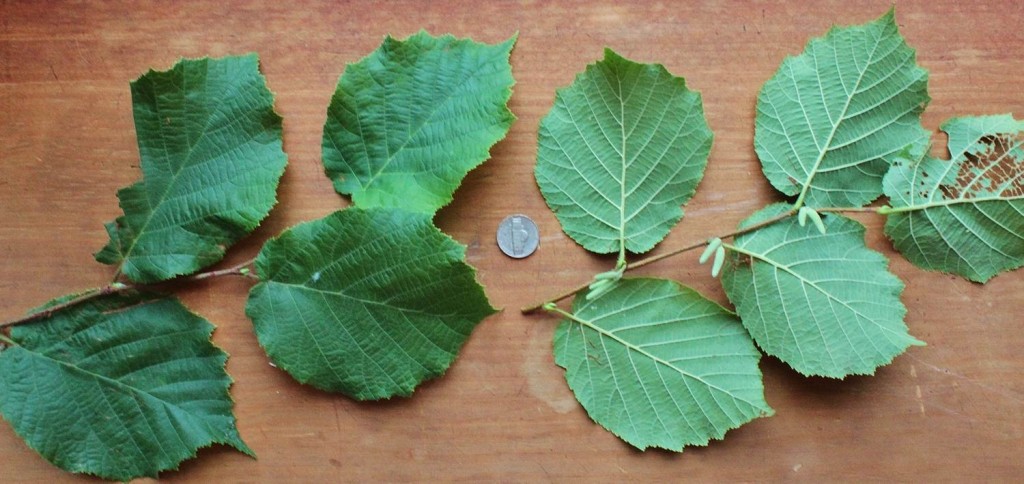
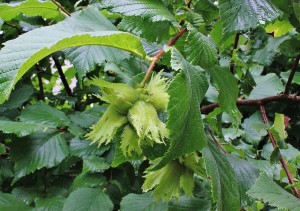
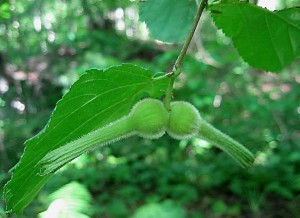
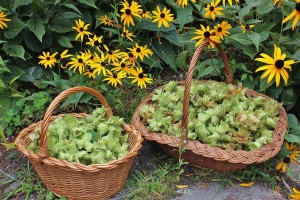
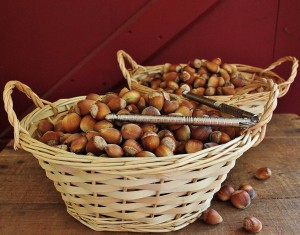
Pingback: Autumnberry ice cream pie with hazelnuts - One Acre Farm
Do you know if the beaked will cross-pollinate with the American Hazelnut. I only have room for 2 and I was thinking one for me and one for the squirrels.
One for me and one for the squirrels?
How are you going to get the squirrels to understand that?
Hi Lora. You know, that’s an excellent question, it’s something I’ve wondered about but have not been able to find a definite answer. My guess is that they do not freely cross pollinate, because if they did we’d probably see wild hybrid hazels with nuts that look a little different from both parent species. So, I would get 2 plants of either C. americana or C. cornuta. Another option, for bigger nuts, would be to get a shrub hazel that is a hybrid of American hazel and a European hazel. These hybrids carry the blight resistance of American hazel, but produce bigger nuts like the European. One such hybrid is called Precocious. I have 3 of these in my yard and they are wonderful. You can find them here: http://www.oikostreecrops.com/Nuts/Hazelnuts/Precocious-Hazelnut/p-60-74-264/
How is your precocious hazelnut shrubs? I just bought some and wondered how many nuts should I expect for each one?
Hi Jim, I’ve never actually weighed the yield, but I can say that mine are packed with nuts at harvest time. Some percentage of them (2-25%?) are no good (didn’t get pollinated or attacked by a pest). As long as you plant the shrubs together so they can easily pollinate each other, and as long as sun exposure is good, they should do well. Hope that helps…a little.
Have you gotten any nuts get? I’d be surprised if you did. Any way I planned 3 shrubs five years ago and harvested my first crop last year. It wasn’t a very large crop with only one of the bushes producing any nuts. Total weight was perhaps 4 or 5 pounds if that.
This year, I’ve already begun harvesting. All three bushes have nuts and I’ve gotten at least 5 pounds already, off of ONE BRANCH The squirrels have taken probably as much judging by the amount of debris left behind. The bushes are still loaded.
I’ve read that hazelnut shrubs can take 7 to 25 years, depending on the source, to fully mature and produce in quantity with yields of up to 50 pounds per shrub. I’m skeptical of that but well see.
Sun is definitely essential. Of my 3 bushes one of them is in partial shade and doesn’t have nearly as many nuts as the others and they are smaller too.
Yes, mine began to bear nuts only 2 or 3 years after planting (they were probably 2-3 ft tall at planting). They are in a sunny spot with rich soil, though. I planted 2 more of them 2-3 years ago, and they are going to take longer. They are in poorer soil and get less sun, and are obviously growing more slowly.
Pingback: Elderberry ice cream with chocolate hazelnut crunch - One Acre Farm
Pingback: Kale Salad with Maple Vinaigrette - One Acre Farm
Do you have any wild hazelnuts for sale?
John
Hi John, No, we finished eating last summer’s harvest by February! I miss them, and have been watching the hazelnut plants bloom and begin to leaf out, in great anticipation of this year’s harvest. Sorry I can’t help!
Please do not plant non-native plants. Wildlife (from insects, butterflies, all the way up to mammals)and plants have evolved together and planting non-native plants ruins the balance. Plant only American hazelnuts or beaked hazelnuts; they are native. Thanks!
Thanks for sharing your opinion. I planted hybrid hazelnuts mostly for my family’s consumption, and I personally find it unrealistic to consume only native plant foods. That would eliminate most garden vegetables, for example. Planting native hazelnuts would be the purist way to go, but the nuts are much smaller, requiring more work for less food. Buying large European hazelnuts that have to be transported from Europe or the west coast is environmentally worse than growing hybrids in the backyard, so I feel my choice is a pretty good one.
bill creed: Ignorant, naive, and WAY too late. Survival of the fittest is nature’s rule. European hazelnuts are grown commercially and are everywhere in the United States. American hazelnuts also grow everywhere like weeds, yet you try to imply that they are endangered. Both make perfectly good food for wildlife. So ridiculous to say don’t grow a wild food that is a weed everywhere. Next you will be wanting to somehow make dandelions extinct in America, because they originated in Europe. Instead of wasting precious time trying to destroy non-native plants, why not accept the biota that exist now and try preserving that. You can’t make time go backwards.
Thanks, Robin. bill’s comment was certainly ignorant. I’m sure he does not consume only foods from native plants and animals. Virtually nobody does. That would mean giving up almost all crops and livestock. He’s just another unthinking, self-righteous, even if well-meaning, person who gives environmentalists a bad name.
Have you harvested this years crop of hazelnuts? I am interested in using unripened hazelnuts in a recipe.
Here in MA, they don’t ripen until late summer – early fall. Right now the nuts are quite tiny and undeveloped, so there is still a long way to go even if you want to pick them before they ripen.
Pingback: Beaked Hazelnut in the Wildlife Garden
Thank you so much for this informative post! Just yesterday my daughter and I noticed a lot of animal commotion around a particular bush in our backyard woods. We investigated and found interesting seed pods that some critters were attempting to eat. We have a beaked hazelnut (identified by your highly accurate photos), and now we–the humans–can’t wait to begin harvesting them! I learned the hard way about the pinch properties of the involucres, but your tips will help save my fingers. Thanks again!
I’m a complete novice, so I also need to ask: Is it possible to over-harvest? Should I leave some pods on the bush?
Hi! I’m so glad this post was useful to you! A good rule of thumb while foraging for just about anything, is to leave some for wildlife, and also for the plant to reproduce. So yes, you should leave some nuts on the bush. But search the surrounding area for more bushes, because if you have one bush doing well enough to fruit prolifically, chances are that there are more in the vicinity. So you might be able to harvest quite a few nuts while still leaving some for wildlife and plant reproduction. Have fun!
Great advice. Thank you! 🙂
It says you have never come across clusters of more than three for beaked? I just went out today to a spot we gather and every cluster is five to ten and very few under that..
Wow, that is impressive, Damien. I’d love to see a photo of that. You can send one to my email address under the Contact section, if you like. Were nuts developing in all the husks? Sometimes there are 2-3 nuts with extra “beaks” that are empty.
Thank you for this spectacularly informative post! I greatly enjoyed reading it. I am new to Western WA, where you can’t take one step in any direction without running into wild hazelnuts, so this is my first year harvesting them. Clusters here are anywhere from one to four, occasionally more than four. It seems to me in general that the “onesies” are usually larger, though I’m not entirely sure that’s always the case. I’ve got a few hundred drying on the porch for about a week now. I’ve read it will take maybe a month or so for them to fully dry. Does that seem about right to you? Many thanks again for your blog post.
Hi Paul, yes, I would agree that the fewer the nuts per cluster, the larger the nuts. It’s not unusual to have large clusters of nuts on American hazel, but I haven’t seen large clusters on Beaked hazel. Not sure which type you found.
As for drying the, the time it takes really depends on weather. If humid, it takes a lot longer. I usually dry for about a week in the husks, then maybe another 1-2 weeks after husks are removed. So maybe a bit less than a month. Crack a few nuts to check. When they are dry, the nutmeats will have shrunk significantly from the inside of the shell and will be crunchy and dry.
Anyway, thanks for your kind words. Enjoy the foraging!
Pingback: Hazelnut harvest is underway! | Curious By Nature
Just found you, lots of information to catch up on – thanks
I had catkins for the first time this fall, so maybe nuts next year?
Yes, most likely you’ll get nuts next year. Look for those tiny little red female flowers in early spring!
Thank you for this post! It’s great to have such a complete story with pictures about such a neat woodland crop.
I am putting hazelnut plants on my wish-list for the Would-Be Farm. Grub out some of the thorn-apples and start a row — or a circle? — of hazelnuts…
Best wishes
You are quite welcome, Amy. Hazelnuts truly are excellent wild edibles, and outstanding in the edible garden. My favorites. Good luck with your farm!
What time of year do you harvest? Thanks!
Hi Brittany, here in Massachusetts, I’m usually picking them in late August, but they’ll be ready earlier further south, and later further north. Pick them when the nuts themselves begin to turn brown. At that time, the involucres will still be mostly green. If you wait till those turn brown, wildlife will have eaten most or all of them already.
Is there a best time of year to plant the bushes?
I have successfully planted them in spring and fall with good results (none died).
HI JANET ARE THERE ANY FARM IN NEW ENGLAND THAT SELL HAZELNUT TREES ? I LIVE IN CONNECTICUT
Hi Eri, I don’t know about farms, but there are most likely garden centers in New England that sell them. If not, you can get them mail order from Stark Brothers.
A few years ago I bought some American Hazlenut tree seedlings from the Arbor Day Foundation, online. They are hardy and do well in damp areas.
Missouri department of conservation sells american hazelnut bushes for extremely low prices. .40 each when bought in bundles of 25.
https://mdc6.mdc.mo.gov/Applications/TreeSeedling/Home/ProductDetails/40?
Thanks so much for publishing this helpful info. Now, if I can just beat the deer and squirrels this year – we have a bumper crop this time here in NH.
Very cool that you have a bumper crop this year! Good luck with your foraging endeavors!
I was curious if any of the Species of the Hazelnut Trees/shrubs would do well in Central Oregon’s Climate because I would love to have a few here for the family as well as the wildlife here.If yes where would be the best place/site to get them from?
Thank you for taking the time to read 🙂
Hi Laurie, I’m not sure, but you should be able to find that information easily online. I believe the tree forms (European hazels) do well in the northwestern US. Various nurseries sell them. Try Stark Brothers, which has a large selection of nut trees, including hazels. You can enter your zip code on their site, which allows them to steer you to plants which do best in your climate.
I live North of the 55th parallel in Northern Alberta, Canada. I have discovered several beaked hazelnuts on my acreage this year. I think I have had them for several years but never noticed them. I just harvested a full ice cream pail yesterday. I am ecstatic to have discovered these way up in the frozen North
That’s great, Gordon. 2015 seems to be a great year for hazelnuts!
Hello,
nowt hat I have finally found this tree (i found a tree) and it had ample nuts, the town came a long and cut them back. I was waiting ever so patiently, watching with anticipation. only to be disappointed. My question, have you ever transplanted this small shrub? I have several of these in the shade under pines at my house. in the 20 years I have lived at my home they have never produced a nut.. thinking of moving them to the sunny side of the yard. any advice? I am in Central Massachusetts.
Hi Lianne,
I have never dug up a hazelnut bush and transplanted it. I bought my plants bare root, and they easily transplant that way. If it’s a big shrub, I doubt it would transplant well. Young specimens of just about any woody plant transplant more easily than mature ones. You could try to root a cutting from a wild hazelnut. A friend of mine successfully rooted a cutting from mine, it looked good for awhile, but then didn’t make it through the winter. But since it did root, it seems that you could make it work with a little protection during its first winter.
I know this is an old post, but someone may want this information. You can layer a hazel by cutting the bark all the way around a sucker about a foot or so off the ground take 4″ or so off all the way around. Hold the bare part to bare ground, cover it with about 3″ of moist soil and a rock or something to hold it down. Come back in a few months and check for root growth. If there is enough, cut between the roots and the bush, dig up the new roots and transplant to your desired location. You should get fruit in a lot less time than growing a new seedling.
I got my Hazelnut shrubs from the county extension service in Ohio. They were small bare root plants. It took about eight years to produce nuts. I suggest a hybrid from a nursery for quicker results. I dried the nuts in my car last year, but I think it was too hot and they became bitter. This year, I spread them out on newspaper in front of a fan.
That’s interesting, Jerry. It’s quite possible that the native ones take longer to produce. My hybrids were small, bare root plants when I planted them, and they produced nuts within a few years. But that could also be that the site is really good: They are down slope from my compost bins, and get good sun exposure.
Hi Janet. My shrubs are in full sun, out in the lawn, and away from any woods. I have alkaline soil which may have slowed them down. I live in Central Ohio. I spend much time birding and hiking. I never noticed any wild ones in this area. The plants are small (5′) but I picked 7 pounds of dried nuts from eight plants. I some left for the wildlife.
Interesting you’ve never seen wild hazels. I think of the midwest as where they thrive.
Hi Janet. I read that they like slightly acidic and deep soil. The soil in Central Ohio is alkaline, full of clay, and has poor drainage. My plants are near a ditch and have some drainage. They took eight years to produce. It is fun. My friends have never seen them. They are amazed.
Thanks for the great information about hazelnuts. I’ve always been interested in botany and wild edibles. I have observed beaked hazelnuts in both Vermont and Maine. My experience is similar to yours in that I most often see them bordering wetlands or marshy areas. I’ve also seen them situated high on river banks. They do seem to favor those edge environments with forest behind them and full sun in front.
Are Hazelnut leaves EDIBLE?
I don’t think so, but not sure.
I got my hazel bushes from Badgersett Research (www (dot) badgersett (dot) com/) — they are breeding hazels and chestnuts for nut quality and quantity, and for hardiness in the midwest. Their research farm is in SE Minnesota. I planted 5 bushes 7 years ago. I’ve been getting crops for the last 3 years, still ramping up. Last year I had 7# of nuts after removing the husks. I’m partway through the harvest this year, trying to stay ahead of the critters, and so far I have three paper grocery bags full, with the biggest bush still untouched. It looks like I’ll have about twice as much as last year. The tallest bush is up to about 9′ – or it was until the weight of the nuts caused some sagging.
Thanks, I hadn’t heard of Badgersett Research. I wonder how their NeoHybrids compare to Precocious hybrids in terms of nut size. It sounds like they began bearing nuts just as early, and producing just as much. Thanks for sharing.
I’ve got my nuts drying and will soon remove the outer involucres. But then what do you do to get to a usable nut?
ie roasting and/or cracking procedure.
Storage ideas?
Thanks for all the great information.
As long as they are dry, you can store them in the shells, and crack them as you need them. You can crack them all and then store, if you prefer, but that is not necessary. If you like the flavor of roasted nuts, roast them after cracking. (I prefer them raw).
I was given a bag of hazelnuts/filberts. The meat is punchy. I got violently ill the night after eating some. I’ve never been allergic to them before, but never had any that were punch either. Could they be poisonous?
What do you mean by punchy? If you mean they were spoiled, then that could be the reason you became ill.
Hi, I would love to plant hazelnuts, but only have a few small spaces in full sun. How much space does each one need? How far apart should they be planted? How far apart can they be planted (say, backyard and front yard) and still pollinate each other? If I wanted to plant a clump of, say, 3 in a triangle shape, what distance should they be from each other? How much space would I need to allow for the whole clump?
Thank you,
Beyla
My friend said that you can grow a hazelnut plant from the nut if you just put them on the ground in the spring. I would like to plant some from nuts, but I think I’ll bury them an inch down in soft soil. This year i came upon some by the roadside when I pulled over to answer my cell phone. I’m going back next week and getting a few before anybody else (human or animal) beats me to them. Then, I’m going to go to the Pawpaw grove and see if there are any Pawpaws on the ground. I still haven’t found any beaked hazelnuts, but they look cool!
Pingback: Sacred Trees in the Americas: American Hazel (Corylus americana) Magic, Ecology, and Sacred Uses | The Druid's Garden
I planted about 30 Jefferson Hazelnuts from seed in 2018 and some are about 6′ tall now. They haven’t produced any catkins yet, but do you think there is a chance they will next year. Also I planted 50 Amarican Hazelnut seedlings from the Missouri Forrest service among them this spring. Will they cross polinate?
I’m in Central Arkansas by the way zone 7B